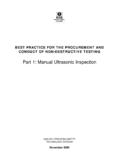Transcription of Part 2: Magnetic Particle and Dye - Health and Safety ...
1 best PRACTICE FOR THE procurement ANDCONDUCT OF NON- destructive TESTINGPart 2: Magnetic Particle and DyePenetrant InspectionGAS AND CHEMICAL PROCESS SAFETYTECHNOLOGY DIVISIONA pril 2002 3 The recommendations contained in this document were aimed specifically to improve the inspection of conventional pressurised equipment. However, the drafting committee considers that these measures can also apply to any application of Magnetic Particle and Dye Penetrant Inspection including fairground or railway components, offshore equipment, and conventional plant in nuclear installations.
2 H Bainbridge Gas and Chemical Process Safety Technology Division Health and Safety Executive 1. INTRODUCTION Following the successful production of the Health and Safety Executive (HSE) document describing best practice for the procurement and application of manual ultrasonics [Ref. 1], the HSE have judged it appropriate to issue further best practice guidelines which identify when problems can arise in the selection and application of other NDT methods and what solutions might be adopted.
3 The measures contained in this document are recommended by the HSE for the conduct of Magnetic Particle and dye penetrant inspection1. They are intended to promote the adoption of good practice and apply to in-service inspection of existing plant and to repairs. The guidelines could also be applicable to the inspections carried out during the manufacture of new or replacement plant. They apply both to inspections carried out by the NDT department of the company owning or manufacturing the plant and to those carried out by external NDT organisations under contract.
4 In the latter case, they are intended to assist in the procurement process by highlighting the issues that need consideration. These measures are not intended to replace the relevant technical standards or to supersede them in any way. They identify the many factors which are important in the choice and application of the two methods, including technical ones. However, they do not provide any direction on the values to be adopted for the different technical parameters. This is the role of the detailed technical standards and the specific procedures derived from them.
5 The guidelines also identify important issues beyond those covered in standards such as organisational matters and provide recommendations on these. The guidelines have been drawn up by a committee of experts assembled by the HSE for this purpose. Their names and affiliations are given in Appendix 1, from which it will be apparent that they represent a very wide range of those parts of British industry using the relevant NDT methods. In addition, they have considerable expertise in and responsibility for the application of NDT to industrial plant.
6 The recommendations contained in these guidelines are based on two main sources. The first is a literature search and subsequent review of relevant published papers and articles regarding the reliability of the application of Magnetic Particle and dye penetrant inspection. The second basis for the recommendations is the collective experience and expertise of the committee mentioned earlier. Many of the members were also members of the PANI Management Committee and the committee responsible for the best practice document on manual ultrasonics.
7 Both sources of information support the view that, if incorrectly chosen or incorrectly applied, both inspection methods can be ineffective. Defects may be overlooked or, alternatively, spurious indications may be mistaken for genuine defects, leading to unnecessary rejection of components or repairs. As a notable example, the NORDTEST trial results [Ref. 2] performed on 635 surface-breaking defects, in a total of 133 different specimens, inspected by 14 to 16 teams showed the following: 57% detection rate for defects 2 mm deep rising to 93% for defects 8 mm deep when applying MPI; 44% detection rate for defects 10 mm long rising to 59% for defects 70 mm long when applying MPI; 70% detection rate for defects 2 mm deep rising to 92% for defects 5 mm deep when applying dye penetrant.
8 60% detection rate for defects 10 mm long rising to 65% for defects 50 mm long when applying dye penetrant; 1 The term inspection is commonly used to mean both NDT and inspection in its wider sense. Throughout this document, it is used to mean NDT. The words inspector and operator are used interchangeably throughout the document to refer to those who apply and design NDT techniques. These results and others, together with the experience of the members of the committee, provide the incentive for production of these guidelines.
9 Section 2 of this document contains notes on the way a surface defect detection method is chosen, depending on the particular circumstances of the inspection. It also describes the different ways in which the methods can be applied in practice and the factors which determine how the choice is made. Section 3 contains a review of the current way in which most Magnetic Particle and dye penetrant inspections are designed and carried out and the way in which the quality of the inspection is assured.
10 Section 4 provides an analysis of potential problems in method / technique application together with a list of the measures which can be adopted in response. In doing this, it is recognised that the extent to which it is reasonable to include additional features in the inspection, and incur additional costs as a result, depends on the role of the inspection in assuring plant Safety , the economics of the inspection activity and the consequences of the inspection failing to achieve its objectives.










